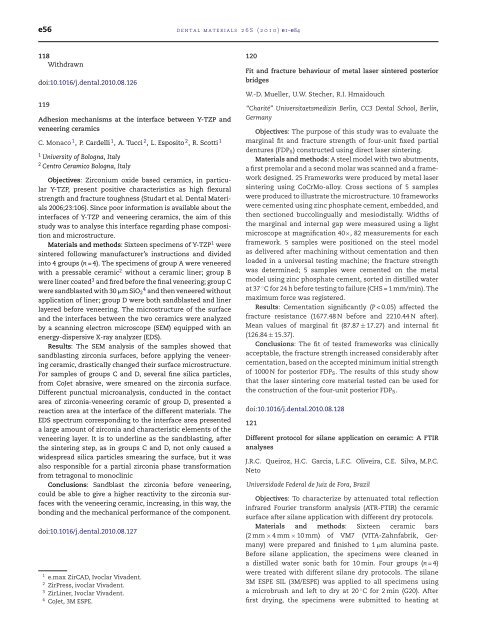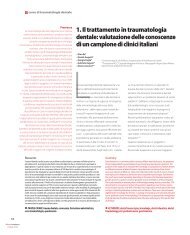Abstracts of the Academy of Dental Materials Annual ... - IsiRed
Abstracts of the Academy of Dental Materials Annual ... - IsiRed
Abstracts of the Academy of Dental Materials Annual ... - IsiRed
You also want an ePaper? Increase the reach of your titles
YUMPU automatically turns print PDFs into web optimized ePapers that Google loves.
e56 dental materials 26S (2010) e1–e84<br />
118<br />
Withdrawn<br />
doi:10.1016/j.dental.2010.08.126<br />
119<br />
Adhesion mechanisms at <strong>the</strong> interface between Y-TZP and<br />
veneering ceramics<br />
C. Monaco 1 , P. Cardelli 1 , A. Tucci 2 , L. Esposito 2 , R. Scotti 1<br />
1 University <strong>of</strong> Bologna, Italy<br />
2 Centro Ceramico Bologna, Italy<br />
Objectives: Zirconium oxide based ceramics, in particular<br />
Y-TZP, present positive characteristics as high flexural<br />
strength and fracture toughness (Studart et al. <strong>Dental</strong> <strong>Materials</strong><br />
2006;23:106). Since poor information is available about <strong>the</strong><br />
interfaces <strong>of</strong> Y-TZP and veneering ceramics, <strong>the</strong> aim <strong>of</strong> this<br />
study was to analyse this interface regarding phase composition<br />
and microstructure.<br />
<strong>Materials</strong> and methods: Sixteen specimens <strong>of</strong> Y-TZP 1 were<br />
sintered following manufacturer’s instructions and divided<br />
into 4 groups (n = 4). The specimens <strong>of</strong> group A were veneered<br />
with a pressable ceramic 2 without a ceramic liner; group B<br />
were liner coated 3 and fired before <strong>the</strong> final veneering; group C<br />
were sandblasted with 30 �m SiO2 4 and <strong>the</strong>n veneered without<br />
application <strong>of</strong> liner; group D were both sandblasted and liner<br />
layered before veneering. The microstructure <strong>of</strong> <strong>the</strong> surface<br />
and <strong>the</strong> interfaces between <strong>the</strong> two ceramics were analyzed<br />
by a scanning electron microscope (SEM) equipped with an<br />
energy-dispersive X-ray analyzer (EDS).<br />
Results: The SEM analysis <strong>of</strong> <strong>the</strong> samples showed that<br />
sandblasting zirconia surfaces, before applying <strong>the</strong> veneering<br />
ceramic, drastically changed <strong>the</strong>ir surface microstructure.<br />
For samples <strong>of</strong> groups C and D, several fine silica particles,<br />
from CoJet abrasive, were smeared on <strong>the</strong> zirconia surface.<br />
Different punctual microanalysis, conducted in <strong>the</strong> contact<br />
area <strong>of</strong> zirconia-veneering ceramic <strong>of</strong> group D, presented a<br />
reaction area at <strong>the</strong> interface <strong>of</strong> <strong>the</strong> different materials. The<br />
EDS spectrum corresponding to <strong>the</strong> interface area presented<br />
a large amount <strong>of</strong> zirconia and characteristic elements <strong>of</strong> <strong>the</strong><br />
veneering layer. It is to underline as <strong>the</strong> sandblasting, after<br />
<strong>the</strong> sintering step, as in groups C and D, not only caused a<br />
widespread silica particles smearing <strong>the</strong> surface, but it was<br />
also responsible for a partial zirconia phase transformation<br />
from tetragonal to monoclinic<br />
Conclusions: Sandblast <strong>the</strong> zirconia before veneering,<br />
could be able to give a higher reactivity to <strong>the</strong> zirconia surfaces<br />
with <strong>the</strong> veneering ceramic, increasing, in this way, <strong>the</strong><br />
bonding and <strong>the</strong> mechanical performance <strong>of</strong> <strong>the</strong> component.<br />
doi:10.1016/j.dental.2010.08.127<br />
1 e.max ZirCAD, Ivoclar Vivadent.<br />
2 ZirPress, ivoclar Vivadent.<br />
3 ZirLiner, Ivoclar Vivadent.<br />
4 CoJet, 3M ESPE.<br />
120<br />
Fit and fracture behaviour <strong>of</strong> metal laser sintered posterior<br />
bridges<br />
W.-D. Mueller, U.W. Stecher, R.I. Hmaidouch<br />
“Charité” Universitaetsmedizin Berlin, CC3 <strong>Dental</strong> School, Berlin,<br />
Germany<br />
Objectives: The purpose <strong>of</strong> this study was to evaluate <strong>the</strong><br />
marginal fit and fracture strength <strong>of</strong> four-unit fixed partial<br />
dentures (FDPS) constructed using direct laser sintering.<br />
<strong>Materials</strong> and methods: A steel model with two abutments,<br />
a first premolar and a second molar was scanned and a framework<br />
designed. 25 Frameworks were produced by metal laser<br />
sintering using CoCrMo-alloy. Cross sections <strong>of</strong> 5 samples<br />
were produced to illustrate <strong>the</strong> microstructure. 10 frameworks<br />
were cemented using zinc phosphate cement, embedded, and<br />
<strong>the</strong>n sectioned buccolingually and mesiodistally. Widths <strong>of</strong><br />
<strong>the</strong> marginal and internal gap were measured using a light<br />
microscope at magnification 40×, 82 measurements for each<br />
framework. 5 samples were positioned on <strong>the</strong> steel model<br />
as delivered after machining without cementation and <strong>the</strong>n<br />
loaded in a universal testing machine; <strong>the</strong> fracture strength<br />
was determined; 5 samples were cemented on <strong>the</strong> metal<br />
model using zinc phosphate cement, sorted in distilled water<br />
at 37 ◦ C for 24 h before testing to failure (CHS = 1 mm/min). The<br />
maximum force was registered.<br />
Results: Cementation significantly (P < 0.05) affected <strong>the</strong><br />
fracture resistance (1677.48 N before and 2210.44 N after).<br />
Mean values <strong>of</strong> marginal fit (87.87 ± 17.27) and internal fit<br />
(126.84 ± 15.37).<br />
Conclusions: The fit <strong>of</strong> tested frameworks was clinically<br />
acceptable, <strong>the</strong> fracture strength increased considerably after<br />
cementation, based on <strong>the</strong> accepted minimum initial strength<br />
<strong>of</strong> 1000 N for posterior FDPS. The results <strong>of</strong> this study show<br />
that <strong>the</strong> laser sintering core material tested can be used for<br />
<strong>the</strong> construction <strong>of</strong> <strong>the</strong> four-unit posterior FDPS.<br />
doi:10.1016/j.dental.2010.08.128<br />
121<br />
Different protocol for silane application on ceramic: A FTIR<br />
analyses<br />
J.R.C. Queiroz, H.C. Garcia, L.F.C. Oliveira, C.E. Silva, M.P.C.<br />
Neto<br />
Universidade Federal de Juiz de Fora, Brazil<br />
Objectives: To characterize by attenuated total reflection<br />
infrared Fourier transform analysis (ATR-FTIR) <strong>the</strong> ceramic<br />
surface after silane application with different dry protocols.<br />
<strong>Materials</strong> and methods: Sixteen ceramic bars<br />
(2 mm × 4mm× 10 mm) <strong>of</strong> VM7 (VITA-Zahnfabrik, Germany)<br />
were prepared and finished to 1 �m alumina paste.<br />
Before silane application, <strong>the</strong> specimens were cleaned in<br />
a distilled water sonic bath for 10 min. Four groups (n =4)<br />
were treated with different silane dry protocols. The silane<br />
3M ESPE SIL (3M/ESPE) was applied to all specimens using<br />
a microbrush and left to dry at 20 ◦ C for 2 min (G20). After<br />
first drying, <strong>the</strong> specimens were submitted to heating at



